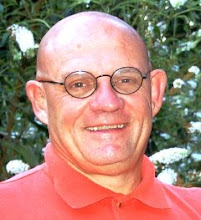
If you know much about the Great Smoky Mountains National Park, you know that much is made of the synchronous fireflies
(Photinus carolinus) that appear every June in the Elkmont region of the park.
Two years ago we journeyed with some friends into the Park to try to catch one of the buses that carried you into Elkmont, supposedly the only place in the Smokies (and the world) to view the lightning bugs. Even though we got there several hours before dark, the parking lot was jammed with bug-watchers. A park ranger waved us away. That left a bad taste in my mouth.
Last night I was walking through my back field to my neighbor's house just before dark and lo and behold I was flashed in unison by hundreds of Deerfield's very own fireflies. I noticed immediately that these fireflies had a brighter luminescence than your average run-of-the-mill firefly. When I looked out across the field, there seemed to be several distinct groups of the fireflies, but there was no doubt that they were timing their flashes.
Here's what the Park literature says about the bugs:
Synchronous fireflies are beetles. They take from one to two years to mature from larvae, but will live as adults for only about 21 days. The males fly and flash and the usually stationary females respond with a flash. Peak flashing for synchronous fireflies in the park is normally within a two-week period in mid-June.
No one is sure why the fireflies flash synchronously. Competition between males may be one reason: they all want to be the first to flash. Or perhaps if the males all flash together they have a better chance of being noticed, and the females can make better comparisons. The fireflies do not always flash in unison. They may flash in waves across hillsides, and at other times will flash randomly. Synchrony occurs in short bursts that end with abrupt periods of darkness.Skeptic that I am, I always wondered how the fireflies managed to stay cloistered in one little area of the Smokies. Now we know their secret.
Welcome to Deerfield, little lanterns. May your 21 days on this earth be pleasant and bright.

 Several readers have asked how the renovation of the Vawter House in McKenzie, Tenn., is coming. I can report that it will be ready by July 4th as planned.
Several readers have asked how the renovation of the Vawter House in McKenzie, Tenn., is coming. I can report that it will be ready by July 4th as planned.



